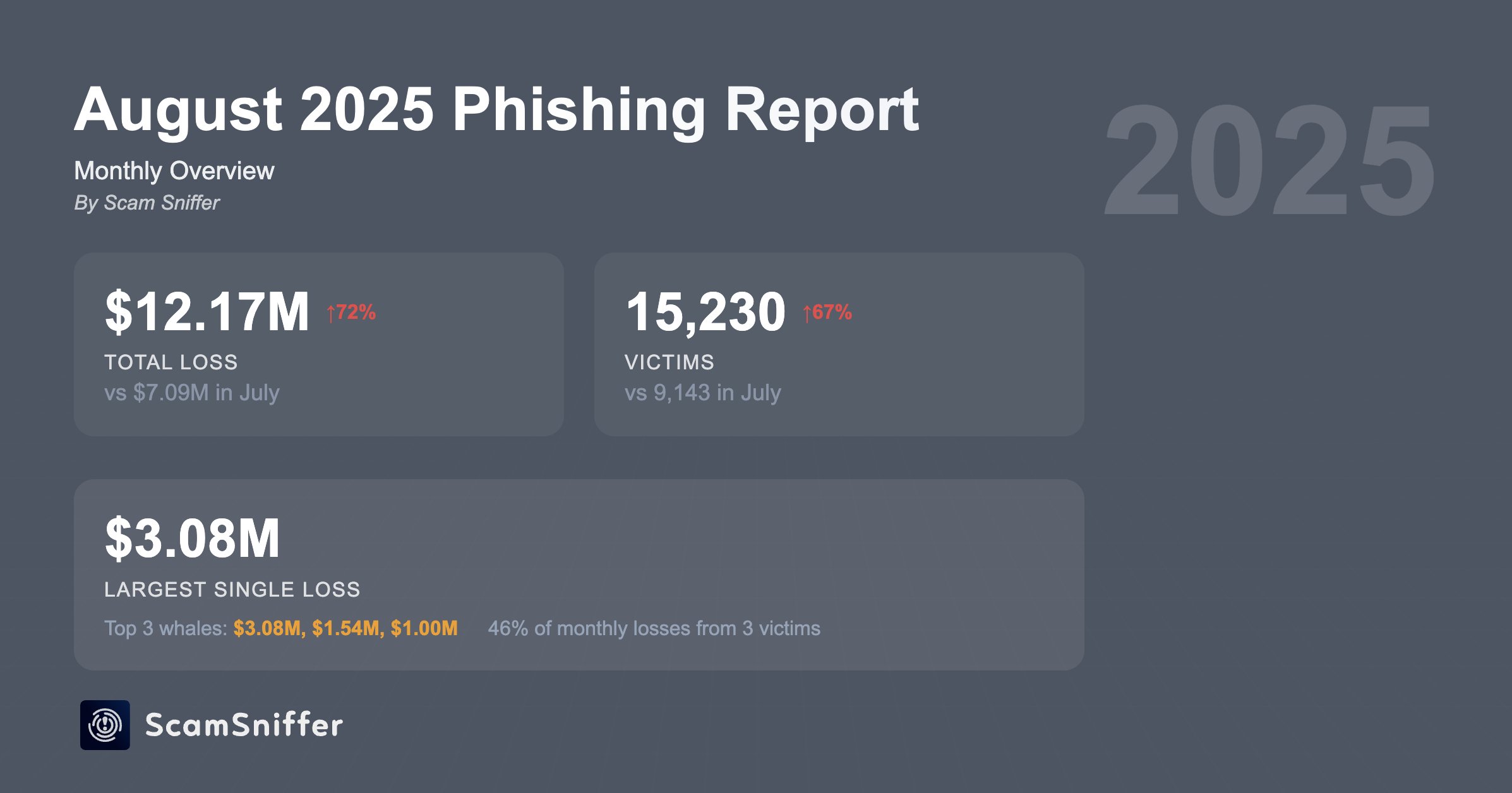Crypto phishing scams surged in August 2025, costing users millions and targeting wallets via EIP-7702 signature exploits; immediately verify URLs, enable two-factor authentication, never share seed phrases, and follow the step-by-step defenses below to reduce risk and protect funds.
-
Crypto phishing scams rose sharply in Aug 2025, with $12M lost and 15,230 victims.
-
Attackers increasingly exploit EIP-7702 signature flows to drain wallets; three attacks stole $5.6M.
-
Practical defenses: verify URLs, bookmark trusted sites, enable 2FA, use VPNs, and never share seed phrases.
Crypto phishing scams surged in Aug 2025, costing users millions. Learn top anti-phishing measures, EIP-7702 risks, and quick steps to secure wallets now.
Phishing scams continue to impact crypto and Web3 users, prompting urgent vigilance and practical countermeasures to protect wallets and credentials.
Phishing scams, where attackers pose as legitimate platforms or services to harvest credentials or trick users into signing malicious transactions, cost crypto users over $12 million in August 2025 — a 72% increase from July, according to Scam Sniffer (data reported September 2025).
Scam Sniffer recorded 15,230 victims in August 2025, a 67% month-on-month rise, with the largest single reported loss exceeding $3 million. Security researchers also highlighted a marked escalation in EIP-7702 signature scams that allowed attackers to misuse Externally Owned Accounts acting as smart contract wallets.

Scammers exploited these signature mechanisms in three separate incidents in August, collectively draining over $5.6 million. Overall malicious activity and exploits accounted for more than $163 million lost in August 2025, underscoring a persistent threat environment for crypto users.
What are crypto phishing scams?
Crypto phishing scams are fraudulent attempts to trick Web3 users into revealing private keys, seed phrases, passwords, or signing malicious transactions, often via deceptive emails, fake websites, or social-engineered messages. These attacks aim to transfer funds or install malware that enables future theft.
How are EIP-7702 signature scams exploited?
Attackers leverage EIP-7702 by creating flows that prompt Externally Owned Accounts to sign or approve contract-like actions that move assets. In August 2025, three related incidents used crafted signatures to authorize large transfers, resulting in combined losses above $5.6M.
How can users stay safe against phishing scams?
Protecting funds requires multiple layered defenses. Follow these concise, actionable practices designed for crypto and Web3 users.
- Verify URLs and domains: Always check for subtle typos, homoglyphs, or extra subdomains. Bookmark official sites instead of using search results.
- Protect seed phrases: Never disclose seed phrases or private keys to anyone or paste them into websites or chat windows.
- Use hardware wallets: Keep long-term holdings and large transfers on hardware devices where private keys never leave the device.
- Enable two-factor authentication (2FA): Use authentication apps or hardware keys for exchange and email accounts.
- Use a VPN and secure networks: Avoid public Wi‑Fi for wallet access and mask your IP when connecting to critical services.
- Review transaction details: Before signing, verify contract addresses, amounts, and requested allowances in your wallet UI.
- Keep software updated: Maintain browser extensions, wallet apps, and device OS with the latest security patches.
How should users respond after a suspected phishing event?
Immediately revoke allowances, move remaining funds to a new wallet with a fresh seed stored offline, change passwords on linked accounts, and report the incident to relevant platforms and anti-scam services. Maintain forensic evidence such as message screenshots and transaction IDs.
Comparison: July vs August 2025 phishing metrics
| Metric | July 2025 | August 2025 |
|---|---|---|
| Phishing losses | $7.0M (approx.) | $12M |
| Number of victims | ~9,120 | 15,230 |
| EIP-7702 related theft | Limited reported cases | $5.6M across 3 attacks |
Frequently Asked Questions
How much did phishing scams cost in August 2025?
Phishing scams cost crypto users over $12 million in August 2025, a 72% increase from July; 15,230 victims were recorded, with individual losses up to $3M, per Scam Sniffer data.
What is EIP-7702 and why is it risky?
EIP-7702 enables Externally Owned Accounts to act as smart contract wallets capable of executing automated transactions; when abused, it can let attackers authorize transfers via crafted signatures without immediate user awareness.
What immediate steps stop ongoing theft?
Revoke smart contract allowances, transfer remaining funds to a secure wallet, disconnect browser wallet sessions, change passwords, and enable 2FA on related accounts.
Key Takeaways
- Rising threat: Phishing losses and victim counts increased sharply in August 2025, signaling elevated attacker activity.
- EIP-7702 risk: New signature vectors can be abused—users must inspect signature requests and contract approvals.
- Practical defenses: Verify URLs, use hardware wallets and 2FA, revoke allowances, and maintain secure habits.
Conclusion
Crypto phishing scams remain a major source of loss in 2025. Users and custodians must prioritize anti-phishing measures, update operational security, and audit signature requests tied to EIP-7702. Staying informed and following the steps above reduces exposure and helps protect digital assets — start implementing these controls today.
Published by COINOTAG — Published: 2025-09-06 — Updated: 2025-09-06. Data sources referenced as Scam Sniffer and industry reporting (mentioned as plain text).
